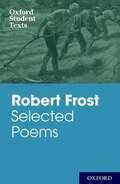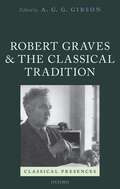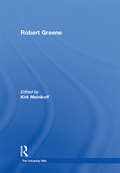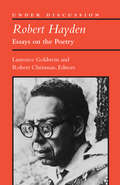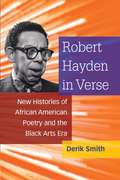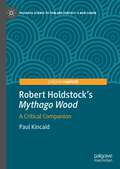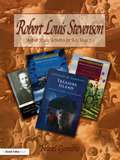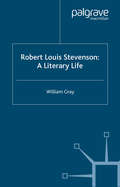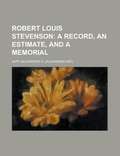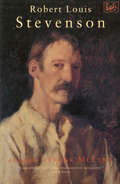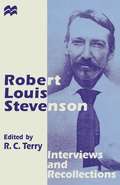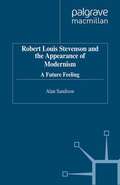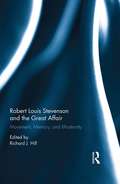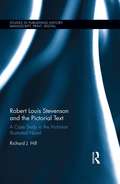- Table View
- List View
Robert Fergusson and the Scottish Periodical Press
by Rhona BrownThough Robert Fergusson published only one collection of poems during his lifetime, he was a fixture in the Scottish periodical press. Rhona Brown explores Fergusson's poetic output in its immediate periodical context, enabling a new understanding of Fergusson's contribution to poetry that also enlarges on our understanding of the Scottish periodical press. Focusing on the development of his career in Walter Ruddiman's Weekly Magazine, Brown situates Fergusson's poetry alongside contemporary events that expose Fergusson's preoccupations with the frivolities of fashion, theatrical culture, the economic status of Scottish manufacture, and politics. At the same time, Brown offers fascinating insights into the political climate of Enlightenment Scotland and shows the Weekly Magazine in relationship to the larger Scottish and British periodical milieus. She concludes by exploring reactions to Fergusson's death in the British periodical presses, arguing that contrary to critical consensus, the poet's death was ignored neither by his own country nor by the larger literary community.
Robert Frost: An Adventure in Poetry, 1900-1918
by Lesley Lee FrancisIn this volume, Lesley Lee Francis, granddaughter of Robert Frost, brings to life the Frost family's idyllic early years. Through their own words, we enter the daily lives of Robert, known as RF to his family and friends, his wife, Elinor, and their four children, Lesley, Carol, Irma, and Marjorie. The result is a meticulously researched and beautifully written evocation of a fleeting chapter in the life of a literary family.Taught at home by their father and mother, the Frost children received a remarkable education. Reared on poetry, nurtured on the world of the imagination, and instructed in the art of direct observation, the children produced an exceptional body of writing and artwork in the years between 1905 and 1915. Drawing upon previously unexamined journals, notebooks, letters, and the little magazine entitled The Bouquet produced by the Frost children and their friends, Francis shows how the genius of Frost was enriched by his interactions with his children. Francis depicts her grandfather as a generous, devoted, and playful man with a striking ability to communicate with his children and grandchildren. She traces the family's adventures from their farm years in New Hampshire through their nearly three years in England. This enchanting evocation of the Frost family's life together makes more poignant the unforeseen personal tragedies that would befall its members in later years.
Robert Frost: An Adventure in Poetry, 1900-1918
by Lesley Lee FrancisIn this volume, Lesley Lee Francis, granddaughter of Robert Frost, brings to life the Frost family's idyllic early years. Through their own words, we enter the daily lives of Robert, known as RF to his family and friends, his wife, Elinor, and their four children, Lesley, Carol, Irma, and Marjorie. The result is a meticulously researched and beautifully written evocation of a fleeting chapter in the life of a literary family.Taught at home by their father and mother, the Frost children received a remarkable education. Reared on poetry, nurtured on the world of the imagination, and instructed in the art of direct observation, the children produced an exceptional body of writing and artwork in the years between 1905 and 1915. Drawing upon previously unexamined journals, notebooks, letters, and the little magazine entitled The Bouquet produced by the Frost children and their friends, Francis shows how the genius of Frost was enriched by his interactions with his children. Francis depicts her grandfather as a generous, devoted, and playful man with a striking ability to communicate with his children and grandchildren. She traces the family's adventures from their farm years in New Hampshire through their nearly three years in England. This enchanting evocation of the Frost family's life together makes more poignant the unforeseen personal tragedies that would befall its members in later years.
Robert Frost and New England: The Poet As Regionalist
by John C. KempThough critics traditionally have paid homage to Robert Frost's New England identity by labeling him a regionalist, John Kemp is the first to investigate what was in fact a highly complex relationship between poet and region. Through a frankly revisionist interpretation, he not only demonstrates how Frost's relationship to New England and his attempt to portray himself as the "Yankee farmer poet" affected his poetry; he also shows that the regional identity became a problem both for Frost and for his readers.Originally published in 1979.The Princeton Legacy Library uses the latest print-on-demand technology to again make available previously out-of-print books from the distinguished backlist of Princeton University Press. These editions preserve the original texts of these important books while presenting them in durable paperback and hardcover editions. The goal of the Princeton Legacy Library is to vastly increase access to the rich scholarly heritage found in the thousands of books published by Princeton University Press since its founding in 1905.
The Robert Frost Encyclopedia (Non-ser.)
by Nancy L. Tuten John ZubizarretaOften thought of as the quintessential poet of New England, Robert Frost is one of the most widely read American poets of the 20th century. He was a master of poetic form and imagery, his works seemed to capture the spirit of America, and he became so emblematic of his country that he read his work at President Kennedy's inauguration and traveled to Israel, Greece, and the Soviet Union as an emissary of the U.S. State Department. While many readers think of him as the personification of New England, he was born in San Francisco, published his first book of poetry in England, matured as a poet while abroad, taught for several years at the University of Michigan, and spent many of his winters in Florida. This reference helps illuminate the hidden complexities of his life and work.Included in this volume are hundreds of alphabetically arranged entries on Frost's life and writings. Each of his collected poems is treated in a separate entry, and the book additionally includes entries on such topics as his public speeches, various colleges and universities with which he was associated, the honors that he won, his biographers, films about him, poets, and others whom he knew, and similar items. Each entry is written by an expert contributor and closes with a brief bibliography. The volume also provides a chronology and concludes with a general bibliography of major studies.
Robert Graves and the Classical Tradition (Classical Presences)
The poet Robert Graves' use of material from classical sources has been contentious to scholars for many years, with a number of classicists baulking at his interpretation of myth and his novelization of history, and questioning its academic value. This collection of essays provides the latest scholarship on Graves' historical fiction (for example in I, Claudius and Count Belisarius) and his use of mythical figures in his poetry, as well as an examination of his controversial retelling of the Greek Myths. The essays explore Graves' unique perspective and expand our understanding of his works within their original context, while at the same time considering their relevance in how we comprehend the ancient world.
Robert Greene (The University Wits)
by Kirk MelnikoffWhile Robert Greene was the most prolific and perhaps the most notorious professional writer in Elizabethan England, he continues to be best known for his 1592 quip comparing Shakespeare to "an upstart crow." In his short twelve-year career, Greene wrote dozens of popular pamphlets in a variety of genres and numerous professional plays. At his premature death in 1592, he was a bonafide London celebrity, simultaneously maligned as Grub-Street profligate and celebrated as literary prodigy. The present volume constitutes the first collection of Greene's reception both in the early modern period and in our present era, offering in its poems, prose passages, essays, and chapters that which is most singular among what has been written about Greene and his work. It also includes a complete list of Greene's contemporary reception until 1640. Kirk Melnikoff's wide-ranging and revisionist introduction organizes this reception generically while at the same time situating it in the context of recent critical methodologies.
Robert Greene (The University Wits)
by Kirk MelnikoffWhile Robert Greene was the most prolific and perhaps the most notorious professional writer in Elizabethan England, he continues to be best known for his 1592 quip comparing Shakespeare to "an upstart crow." In his short twelve-year career, Greene wrote dozens of popular pamphlets in a variety of genres and numerous professional plays. At his premature death in 1592, he was a bonafide London celebrity, simultaneously maligned as Grub-Street profligate and celebrated as literary prodigy. The present volume constitutes the first collection of Greene's reception both in the early modern period and in our present era, offering in its poems, prose passages, essays, and chapters that which is most singular among what has been written about Greene and his work. It also includes a complete list of Greene's contemporary reception until 1640. Kirk Melnikoff's wide-ranging and revisionist introduction organizes this reception generically while at the same time situating it in the context of recent critical methodologies.
Robert Greene's Planetomachia (Literary and Scientific Cultures of Early Modernity)
by Nandini DasWhen Planetomachia was published in 1585, Greene himself-always the best advertiser of his own books-promised his readers a perfectly balanced diet of edification and entertainment. He described his newest offering as an astronomical discourse on the nature and influence of the planets interlaced with 'pleasant and tragical histories,' which one could ostensibly use as a manual to identify various planetary influences on 'natural constitution.' In this first complete critical edition, Nandini Das presents Planetomachia as a complex hybrid which is eminently a product of its times, exploring how the two very different intellectual and cultural spheres of Humanist scholarship and Renaissance popular print engage in an intriguing, albeit uneasy, dialogue to produce this unique work of prose fiction. The volume gives a clear sense, afforded by no other existing edition, of the intellectual climate which shaped this text. It offers substantial introductory material (on biographical, literary and scientific contexts) and extensive annotation identifying Greene's allusions and elucidating his vocabulary. It also includes translations and extracts from significant sources, along with a bibliography of relevant primary texts and critical work on Greene generally and on Planetomachia in particular.
Robert Greene's Planetomachia (Literary and Scientific Cultures of Early Modernity)
by Nandini DasWhen Planetomachia was published in 1585, Greene himself-always the best advertiser of his own books-promised his readers a perfectly balanced diet of edification and entertainment. He described his newest offering as an astronomical discourse on the nature and influence of the planets interlaced with 'pleasant and tragical histories,' which one could ostensibly use as a manual to identify various planetary influences on 'natural constitution.' In this first complete critical edition, Nandini Das presents Planetomachia as a complex hybrid which is eminently a product of its times, exploring how the two very different intellectual and cultural spheres of Humanist scholarship and Renaissance popular print engage in an intriguing, albeit uneasy, dialogue to produce this unique work of prose fiction. The volume gives a clear sense, afforded by no other existing edition, of the intellectual climate which shaped this text. It offers substantial introductory material (on biographical, literary and scientific contexts) and extensive annotation identifying Greene's allusions and elucidating his vocabulary. It also includes translations and extracts from significant sources, along with a bibliography of relevant primary texts and critical work on Greene generally and on Planetomachia in particular.
Robert Hayden: Essays on the Poetry (Under Discussion)
by Laurence Goldstein Robert ChrismanThis collection of essays by leading critics and poets charts Robert Hayden’s growing reputation as a major writer of some of the twentieth century’s most important poems on African-American themes, including the famed “Middle Passage” and “Frederick Douglass.” The essays illuminate the themes and techniques that established Hayden as a modernist writer with affinities to T. S. Eliot, Federico Garcia Lorca, and W. B. Yeats, as well as to traditions of African-American writings that include such figures as Countee Cullen and Langston Hughes. Robert Hayden: Essays on the Poetry is the first and only book to collect significant essays on this distinguished poet. Covering sixty years of commentary, book reviews, essays, and Hayden’s own published materials, this volume is an invaluable contribution to our understanding of the poet’s vision of experience, artistry, and influence. The book includes forty different works that examine the life and poetry of Hayden, the first African-American to serve as Consultant in Poetry to the Library of Congress (the post now called Poet Laureate) and to receive the Grand Prix de la Poesie at the First World Festival of Negro Arts, Dakar, Senegal, in 1966.
Robert Hayden in Verse: New Histories of African American Poetry and the Black Arts Era
by Derik SmithThis book sheds new light on the work of Robert Hayden (1913–80) in response to changing literary scholarship. While Hayden’s poetry often reflected aspects of the African American experience, he resisted attempts to categorize his poetry in racial terms. This fresh appreciation of Hayden’s work recontextualizes his achievements against the backdrop of the Black Arts Movement and traces his influence on contemporary African American poets. Placing Hayden at the heart of a history of African American poetry and culture spanning the Harlem Renaissance to the Hip-Hop era, the book explains why Hayden is now a canonical figure in 20th-century American literature. In deep readings that focus on Hayden’s religiousness, class consciousness, and historical vision, author Derik Smith inverts earlier scholarly accounts that figure Hayden as an outsider at odds with the militancy of the Black Arts movement. Robert Hayden in Verse offers detailed descriptions of the poet’s vigorous contributions to 1960s discourse about art, modernity, and blackness to show that the poet was, in fact, an earnest participant in Black Arts-era political and aesthetic debates.
Robert Holdstock’s Mythago Wood: A Critical Companion (Palgrave Science Fiction and Fantasy: A New Canon)
by Paul KincaidThis book is a detailed examination of one of the most important works of fantasy literature from the twentieth century. It goes through Mythago Wood by Robert Holdstock considering how it engages with war on a personal and family level, how it plays with ideas of time as something fluid and disturbing, and how it presents mythology as something crude and dangerous. The book places Mythago Wood in the context of Holdstock’s other works, noting in part how complex ideas of time have been a consistent element in his fiction. The book also briefly examines how the themes laid out in Mythago Wood are carried through into later books in the sequence as well as the Merlin Codex
Robert Louis Stevenson: Author Study Activities for Key Stage 2/Scottish P6-7
by Nikki GambleFirst Published in 2005. Routledge is an imprint of Taylor & Francis, an informa company.
Robert Louis Stevenson: Author Study Activities for Key Stage 2/Scottish P6-7
by Nikki GambleFirst Published in 2005. Routledge is an imprint of Taylor & Francis, an informa company.
Robert Louis Stevenson: A Literary Life (Literary Lives)
by William GrayMore than most writers, Robert Louis Stevenson requires a Literary Life. Fascination with Stevenson's life (the 'Stevenson biography' is almost a minor genre) has tended to eclipse his literary achievement. This study focuses on Stevenson's writing practice within the different geographical, cultural and political contexts that shaped it, from Scotland to the South Seas. Following Stevenson's own views on biography, the book is not structured primarily in terms of chronology, but is more a kind of literary geography than traditional literary history.
Robert Louis Stevenson: A Record, an Estimate, and a Memorial
by Alexander H. JappThe book has no illustrations or index. Purchasers are entitled to a free trial membership in the General Books Club where they can select from more than a million books without charge. Subjects: History / General; Biography
Robert Louis Stevenson
by Frank McLynnA sensual Calvinist, a Tory radical, a consumptive celebrant of action, a Passionate Scot who chose to live anywhere but Scotland. Not for nothing was Robert Louis Stevenson the author of Dr Jekyll and Mr Hyde.The greatest of Scottish novelists, Stevenson lived a life as extraordinary and as absorbing as his books. But it was a life tormented by an autocratic father, recurring illness, the prudery of the Victorian reading public and, most of all, the stresses imposed on him by his wife and stepchildren. This powerful new study is published to mark the centenery of Stevenson's death at the age of forty-four.
Robert Louis Stevenson: Interviews and Recollections (Interviews and Recollections)
by R. C. TerryAmongst the classics of children's literature, Treasure Island and Kidnapped remain as popular today as ever. And in recent years, there has been a wave of fresh enthusiasm for the author of these novels, with the publication of several new biographies and collections of his letters. Stevenson's reputation has soared and his travel writing is now thought to be of particular interest, providing a unique insight into life on the South Sea islands. This fascinating volume brings together the most memorable interviews and recollections from a wealth of material, portraying the life and times of one of the nineteenth-century's most successful writers.
Robert Louis Stevenson and the Appearance of Modernism: A Future Feeling
by A. SandisonDespite attracting the admiration of Modernists like Nabokov and Borges, Stevenson remains for many an apologist for the lost world of the romance. This is not only to misread and simplify his fiction, it is greatly to undervalue his lively, forward-looking literary essays. Strenously resisting the authority of the literary 'fathers' (though haunted by the complexities of paternity), Stevenson reveals strong affinities with emergent Modernism. It is from this perspective that Alan Sandison's latest book (the first to appear for nearly thirty years) conducts a lively and readable re-examination of this often underrated writer.
Robert Louis Stevenson and the Great Affair: Movement, Memory and Modernity
by Richard J. HillIn his travel narrative Travels with a Donkey in the Cevennes (1879), Robert Louis Stevenson declares, "I travel not to go anywhere, but to go. I travel for travel's sake. The great affair is to move. " Taking up the concepts of time, place, and memory, the contributors to this collection explore in what ways the dynamic view of life suggested by this quotation permeates Stevenson's work. The essays adopt a wide variety of critical approaches, including post-colonial theory, post-structuralism, new historicism, art history, and philosophy, making use of the vast array of literary materials that Stevenson left across a global journey that began in Scotland in 1850 and ended in Samoa in 1894. These range from travel journals, letters, and classic literary staples such as Treasure Island and The Strange Case of Dr. Jekyll and Mr. Hyde, to rarely read masterpieces such as The Master of Ballantrae or The Ebb-Tide. While much recent scholarship on Stevenson foregrounds geography, the present volume also examines the theme of movement across memory, time, and generic boundaries. Taken together, the essays offer a view of Stevenson that demonstrates how the protean nature of his literary output reflects the radical developments in science, technology, and culture that characterized the age in which he lived.
Robert Louis Stevenson and the Great Affair: Movement, Memory and Modernity
by Richard J. HillIn his travel narrative Travels with a Donkey in the Cevennes (1879), Robert Louis Stevenson declares, "I travel not to go anywhere, but to go. I travel for travel's sake. The great affair is to move. " Taking up the concepts of time, place, and memory, the contributors to this collection explore in what ways the dynamic view of life suggested by this quotation permeates Stevenson's work. The essays adopt a wide variety of critical approaches, including post-colonial theory, post-structuralism, new historicism, art history, and philosophy, making use of the vast array of literary materials that Stevenson left across a global journey that began in Scotland in 1850 and ended in Samoa in 1894. These range from travel journals, letters, and classic literary staples such as Treasure Island and The Strange Case of Dr. Jekyll and Mr. Hyde, to rarely read masterpieces such as The Master of Ballantrae or The Ebb-Tide. While much recent scholarship on Stevenson foregrounds geography, the present volume also examines the theme of movement across memory, time, and generic boundaries. Taken together, the essays offer a view of Stevenson that demonstrates how the protean nature of his literary output reflects the radical developments in science, technology, and culture that characterized the age in which he lived.
Robert Louis Stevenson and the Pictorial Text: A Case Study in the Victorian Illustrated Novel (Studies in Publishing History: Manuscript, Print, Digital)
by Richard J. HillRobert Louis Stevenson and the Pictorial Text explores the genesis, production and the critical appreciation of the illustrations to the fiction of Robert Louis Stevenson. Stevenson is one of the most copied and interpreted authors of the late nineteenth century, especially his novels Treasure Island and Strange Case of Dr Jekyll and Mr Hyde. These interpretations began with the illustration of his texts in their early editions, often with Stevenson’s express consent, and this book traces Stevenson’s understanding and critical responses to the artists employed to illustrate his texts. In doing so, it attempts to position Stevenson as an important thinker and writer on the subject of illustrated literature, and on the marriage of literature and visual arts, at a moment preceding the dawn of cinema, and the rejection of such popular tropes by modernist writers of the early twentieth century.
Robert Louis Stevenson and the Pictorial Text: A Case Study in the Victorian Illustrated Novel (Studies in Publishing History: Manuscript, Print, Digital)
by Richard J. HillRobert Louis Stevenson and the Pictorial Text explores the genesis, production and the critical appreciation of the illustrations to the fiction of Robert Louis Stevenson. Stevenson is one of the most copied and interpreted authors of the late nineteenth century, especially his novels Treasure Island and Strange Case of Dr Jekyll and Mr Hyde. These interpretations began with the illustration of his texts in their early editions, often with Stevenson’s express consent, and this book traces Stevenson’s understanding and critical responses to the artists employed to illustrate his texts. In doing so, it attempts to position Stevenson as an important thinker and writer on the subject of illustrated literature, and on the marriage of literature and visual arts, at a moment preceding the dawn of cinema, and the rejection of such popular tropes by modernist writers of the early twentieth century.




